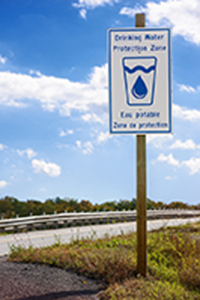In Walkerton, Ontario, a waterfall memorial is dedicated to victims of a severe water tragedy. It is a stark reminder to all of us about the dangers of poor water management. In May 2000, the town of Walkerton was faced with a severe flood event that, along with many other factors, led to the contamination of a municipal well with a deadly bacteria. Until the contamination was identified to residents, they trusted and continued to drink their tap water - with devastating effects. Seven people including one child died due to the contamination, and many residents were left with severe long-term illnesses including neurological damage, arthritis, and kidney failure.
In order to prevent such a tragedy from happening again in Ontario, the Province of Ontario passed laws including the Safe Drinking Water Act (2002) and the Clean Water Act (2006). We need to protect the lakes, rivers and groundwater aquifers that are the sources of our drinking water. Eighty-five per cent of Ontarians rely on municipally treated water which comes from these sources. Removing certain substances that may pose a risk to our source water can be expensive and sometimes, not possible at all.
As well, in some parts of Ontario and during certain times of the year, even the supply of water is threatened from issues such as drought or competing uses. Preventing contamination and depletion from happening to our rivers, lakes and groundwater at the source is the best way to protect our drinking water!
Proposed Provincial changes to the mandate of conservation authorities include that the programs and services of source protection authorities under the Clean Water Act be designated as a mandatory program area. While this is welcomed, watershed management must continue to be the basis by which we protect all sources of drinking water in Ontario, to avoid water tragedies. Effective flood management, drinking water source protection and climate change adaptation can’t be delivered through a patchwork of unrelated projects, programs and services. They need to be planned and implemented on a watershed basis.
Conservation authorities have long supported elements of source water protection through their local watershed programs that help to prevent and manage many source water issues. Conservation authorities also have a strong legislated role under the Clean Water Act as source protection authorities, with funding from the province. The Act focuses on protecting sources of municipal residential drinking water systems, although a few other types of systems may also be included.
Recent flood events across Ontario resulted in several drinking water advisories being issued by some local Health Units, who advised residents not to use private water supplies such as wells due to the high risk of contamination. Preventing contamination of our drinking water sources from flooding, runoff and depletion is a public health priority.
One of the successes of Ontario’s drinking water source protection program is that it allowed conservation authorities, municipalities and the Province to develop scientific information about Ontario’s watersheds, critical water budgets, and more. This information tells us just how fast contaminants can travel to our municipal drinking water sources during a weather event, which activities on the landscape may impact our drinking water sources, and also where municipal water supplies are or could be stressed. It is also necessary to continue to monitor what kinds of contaminants are being released to our vulnerable waterways, and find out where water levels are or could be stressed. This scientific information helps us write policies in local source protection plans that manage our activities on the landscape in order to address growth and development pressures, and climate change impacts. Using up-to-date watershed science and local policies are vital to protecting all of our drinking water sources in Ontario.
The provincial Made-in-Ontario Environmental Plan recognizes the contribution that conservation authorities make to a healthy and safe environment including the protection of our drinking water sources. It states that the Province will continue to protect and identify vulnerable waterways and inland waters and ensure sustainable water use and water security for future generations. The Plan says the Province will work in collaboration with municipalities and stakeholders to ‘ensure that CAs focus and deliver on their core mandate of protecting people and property from flooding and other natural hazards, and conserving natural resources’.
Conservation authorities along with their program partners support Ontario’s public health by ensuring that our drinking water sources are safe and abundant, now and into the future.
Author: Conservation Ontario staff